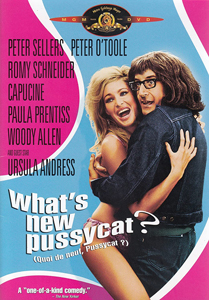I can tell from “What’s New Pussycat” (1965) that Woody Allen has a background in stand-up comedy and theater. His knack for peppering set-ups and zingers into his screenplays (usually in smooth fashion) will be evident throughout his catalog, but it’s his first film writing credit where his stage background shines through.
Farcical romp
Directed by Clive Donner, “What’s New Pussycat” is a farce — in the genre sense, not a quality sense, although I admit I didn’t get into it like I was supposed to. This is partly because farcical romps aren’t to my taste. I ran into this problem when reviewing community theater; I learned to acknowledge when the acting was good, even though the humor rarely connected with me.
As a piece of writing, “Pussycat” – also the pet name lothario Michael James (Peter O’Toole) gives to all women – is an admirable debut from Allen (who, oddly, didn’t write a stage version). The writer explores the true and sad (and apparently endlessly funny, if you’re in the mood) fact that some guys have all the luck and others can’t catch a break.

“What’s New Pussycat” (1965)
Director: Clive Donner
Writer: Woody Allen
Stars: Peter Sellers, Peter O’Toole, Romy Schneider, Woody Allen
We’re supposed to believe that the plights of both Michael and lovesick Dr. Fritz Fassbender (Peter Sellers) are equal in pain though they may be opposite in type.
Somewhere in between the extremes of Michael and Fritz is a man who makes his own luck: Victor, played by Allen, whose standard pick-up line emphasizing his short stature and red hair doesn’t land women. But then his acquisition of a fast sports car works immediately. While the two Peters are good, I found Allen’s appearances to be a relief because Victor is a taste of his future neurotic characters.
Allen the Writer’s rimshot-worthy zingers are good, including this one:
Michael: “Did you find a job?”
Victor: “Yeah, I got something at the striptease. I help the girls dress and undress. … Twenty francs a week.”
Michael: “Not very much.”
Victor: “It’s all I can afford.”
Juggling a huge cast
It’s logistically impressive how Allen brings together the entire cast of characters for a final-act romp at the hookup spot known as Chateau Chantelle (“Pussycat” is set in France, not that it matters much). The closing sequence, wherein various chases morph into go-kart racing and pratfalls, made me smile.
But “whoah oh whoah” does “Pussycat” take a long time getting to this grand finale. I suspect Allen started directing his own screenplays largely because a director has a say in the editing. “Pussycat” is 1 hour, 48 minutes long, and that’s double what it should be.
(Actually, the issue persisted into his directorial debut, 1966’s “What’s Up, Tiger Lily?,” the run time of which was artificially extended by the studio.)
Tighter edit needed
It’s not that any individual scene in the first two acts is horribly incompetent. And certainly there are plenty of beautiful 1960s actresses to admire — including Romy Schneider, Paula Prentiss and Ursula Andress — as they play women magnetically drawn to Michael and repulsed by Fritz.
But there are so many more scenes than are necessary to communicate the point. And a lot of them are merely OK. For example, Miss Lefevre (Capucine) is flattered by a drunken James’ attentions but so disgusted by the soused Fritz’s that she whistles for the police.
Sketch after sketch of this nature makes for viewing as tiring as watching a mediocre “Saturday Night Live,” and indeed, I made my own “commercial breaks.” “Pussycat” is a three-sitting movie. However, it’s an opportunity to learn about Allen’s first credit, so although I won’t be rewatching it, I’m glad I gave “What’s New Pussycat” a look.


